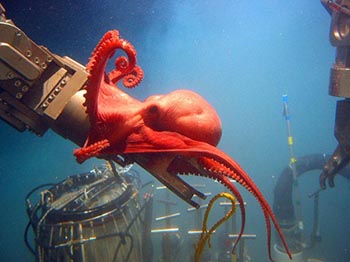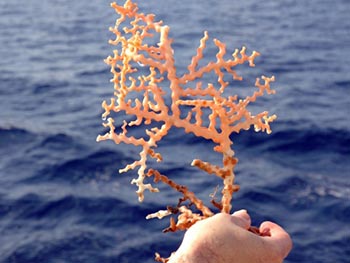
Image courtesy of Bruce Strickrott, Expedition to the Deep Slope.
The Bureau of Ocean Energy Management (BOEM) announces today the availability of a new two-volume study report, Investigations of Chemosynthetic Communities on the Lower Continental Slope of the Gulf of Mexico.
This final report presents the results from a five-year field study funded by BOEM and the National Oceanic and Atmospheric Administration’s Office of Ocean Exploration and Research (NOAA/OER), which was sponsored by the National Oceanographic Partnership Program. The objectives of the study were to discover and characterize the sea floor communities that live in association with hydrocarbon seeps and on hard ground in the deep Gulf of Mexico below a depth of 1,000 meters (3,300 feet). U.S. Geological Survey scientists participated in a complementary biological/genetics study. The findings were used in this report and added to our understanding of these unique communities.
Researchers created photographic mosaics of several new animal communities that were discovered and deployed markers so these sites may be revisited in the future.
A total of 107 new species were confirmed, including 24 undescribed species that do not fit into any described genera. These included many new genera and species of crustaceans - 18 new genera and 77 new species of copepods, one new genera and 17 new species of ostracods, and four new species of tanaidacea.
Researchers also discovered three new species of halacarids – a marine mite in the same class as spiders and more than five new genera of nematodes or round worms. They also discovered one of the largest-known mussel beds in the deep Gulf of Mexico.
“With continuing interest in oil and gas development in deeper Gulf of Mexico waters, it is imperative for BOEM and other stakeholders to know what forms of marine life inhabit those waters in order to safeguard them during energy operations,” said BOEM Acting Director Walter Cruickshank. “The incredible range of discoveries made during this study contributes greatly to our knowledge of the deep Gulf and enables long-term environmental monitoring as resource development takes place.”

The ocean excursions took place in 2006 and 2007, and emphasized both chemosynthetic communities and deep-water or “cold-water” coral communities. Chemosynthetic communities, which may include mussels and tube worms, use chemical energy from inorganic chemicals instead of light energy to produce food. A total of 24 sites were characterized and four sites were studied extensively.
Use of the manned submersible Alvin and the remotely operated vehicle Jason II provided by NOAA OER facilitated the geological, geochemical, microbiological and biological research. Scientists also left markers at these sites so they could be studied over the longer term to determine growth rates of some of the animals, monitor for visitation by mobile deep-sea fauna, and follow the fine scale changes in seepage patterns and community composition.
The two-volume report (OCS Study BOEM 2014-650) is available on BOEM’s Environmental Studies Program Information System (ESPIS). More information is available in Volume I, Volume II: the Appendices and the technical summary. For additional information on BOEM’s Environmental Studies Program, click here, and follow our research on Facebook, Twitter and our other social media channels.
BOEM promotes energy independence, environmental protection and economic development through responsible, science-based management of offshore conventional and renewable energy and marine mineral resources.
